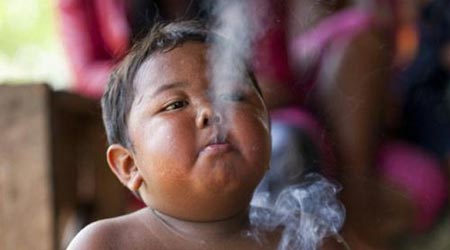Odd News
2-year-old toddler smokes 40 cigarettes a day
(CCTV.com)
Updated: 2010-05-30 21:11
 |
Large Medium Small |
|
 Ardi, who is rarely seen without a cigarette, insists on the same brand, costing £3.78 (US$5.50) a day. [Photo/CCTV.com] |
Taking a deep drag on his cigarette while resting on the steering wheel of his truck, he looks like a parody of a middle-aged lorry driver.
But the image covers up a much more disturbing truth: At just the tender age of two, Ardi Rizal's health has been so ruined by his 40-a-day habit that he now struggles to move by himself.
The four-stone Indonesia toddler is certainly far too unfit to run around with other children - and his condition is set to rapidly deteriorate.
But, despite local officials' offer to buy the Rizal family a new car if the boy quits, his parents feel unable to stop him because he throws massive tantrums if they don't indulge him.
Ardi will smoke only one brand and his habit costs his parents 3.78 British pounds (US$5.50) a day in Musi Banyuasin, in Indonesia's South Sumatra province.
But in spite of this, his fishmonger father Mohammed, 30, said: "He looks pretty healthy to me. I don't see the problem."
Ardi's youth is the extreme of a disturbing trend. Data from the Central Statistics Agency showed 25 percent of Indonesian children aged three to 15 have tried cigarettes, with 3.2 percent of those active smokers.
The percentage of five to nine year olds lighting up increased from 0.4 percent in 2001 to 2.8 percent in 2004, the agency reported.



